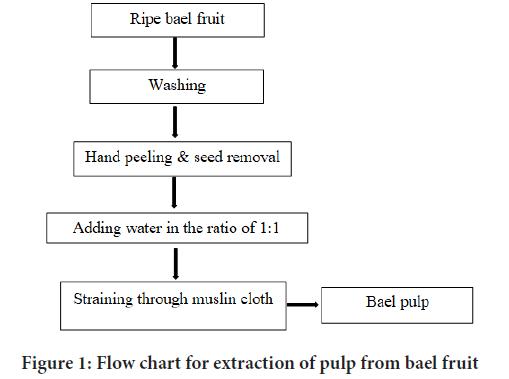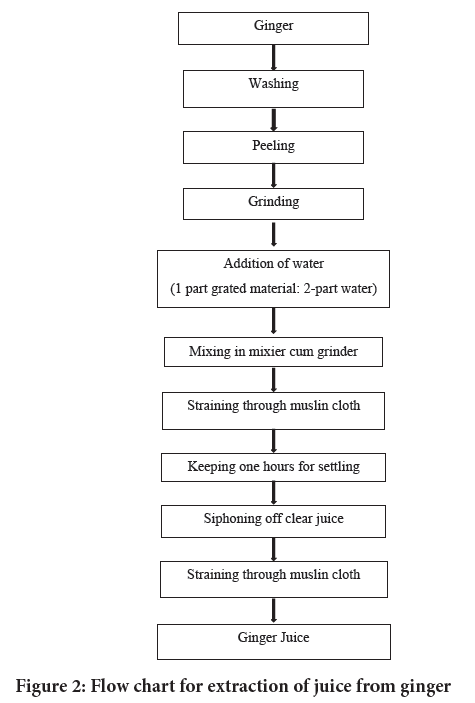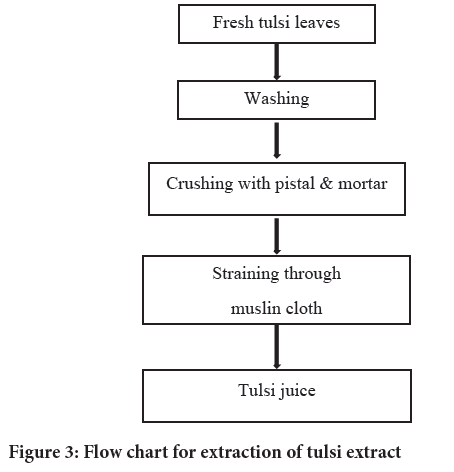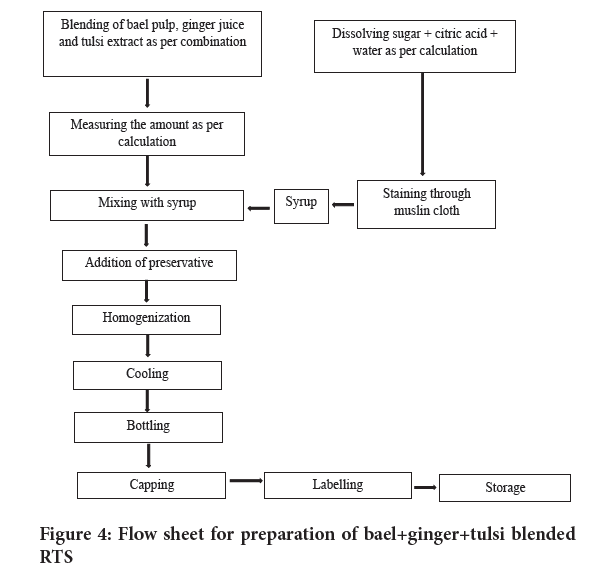Research Article - (2023) Volume 14, Issue 5
Abstract
The present investigation was carried out at Post Graduate Laboratory of Department of Horticulture, School of Agriculture, ITM University Gwalior (M.P.) during the year 2022-2023. The incorporation of sensory, nutritional and medicinal properties of two or more plant species into beverage is possible by blending technology of beverage processing. The RTS prepared from best combination was investigated for its storability. The study revealed that palatable RTS beverage of 10% of blend comprising 70% bael pulp, 15% ginger juice and 15% tulsi extract was found superior on 9-point hedonic scale by semi-trained judges including males and females for the preparation of Ready-To-Serve (RTS) with 13% the Total Soluble Solids (TSS) and 0.20% acidity and 70 ppm SO2 than rest of the blend combinations. The TSS, acidity, reducing sugars and total sugars increased whereas, pH, vitamin-C, non-reducing sugar and organoleptic score decreased continuously up to the termination period of the storage under ambient temperature (23.1°C-28.7°C). Moreover, it had been reported that the beverage could be stored up to 4 months with acceptable sensory quality in polypet bottles.
Keywords
Bael, Ginger, Tulsi, Blended RTS, Polypet bottles, Organoleptic quality, Storage
Introduction
Blending is one of the best methods to improve nutritional quality of a juice. It can improve the vitamin and mineral contents depending upon the kind and quality of fruits and vegetables used (de Carvalho, et al., 2007). Ready-to-serve (RTS) beverages have been increasingly gaining popularity throughout the country due to their health and nutritional benefits apart from providing pleasing flavor and taste. Fruit based RTS beverages and juices are not only rich in essential minerals, vitamins and other nutritive factors but also have a delicious and have a universal appeal (Manan JK, et al., 1992).
Bael (Aegle marmelos Corr.) is an important indigenous fruit of India. It is grown in various parts of South East Asia including India, Sri Lanka, Pakistan, Myanmar, Bangladesh, Thailand and most of the South East Asian countries. In India, bael is being grown throughout the country where it is also known by other vernacular names like bael, bili, bilva, belo, sriphal and Bengal quince. The bael tree has found mention in mythological treatises. Like many other species of Rutaceae family, bael also has fragrant flowers. It is believed that this tree act as indicator plant for tracing of underground water (Singh RN and Roy SK, 1984).
The demand of bael as table fruit is not much higher as other major fruits like mango, banana, guava, apple, etc. The ripe fruit is eaten as a fresh and has a more demand amongst those, who wants it for therapeutic use. Sometimes the pulps are diluted with water and add the requisite amount of sugar and tamarind to prepare delicious cold drink. The bael pulp is used as a base of various fruit products likes squash, jam, slab, toffee, powder, nectar, RTS, etc. Small and tender fruits are preserved and used as pickle similarly, green bael fruits are used for preparing murabba (preserve), which is generally taken in stomach ailments. The green bael fruit slices are often dried and stored for future use.
Ginger (Zingiber officinale Rosc.) is valued as a spice for ages and is also known for its medicinal properties such as to treat in rheumatoid arthritis, ulcer, preventing heart attack and stroke. Ginger is an aromatic tuber crop having volatile oils that account for the aroma of the tubers (Kikuzaki H, et al., 1971). The ginger powder, oleoresin, essence, soft drink, nonalcoholic beverages and ginger oil are manufactured from dry ginger.
Tulsi (Ocimum sanctum Linn.) in Hindi or Tulasi in Sanskrit (holy basil in English) is an exceptionally adored culinary and restorative fragrant herb from the family Lamiaceae that is indigenous to the Indian subcontinent and been utilized inside Ayurvedic medication over 3000 years. Herbal beverages in the form of RTS, squashes, appetizers, health drinks are important from the nutritional point of view. The incorporation of sensory, nutritional and medicinal properties of two or more plant species into beverage is possible by blending technology of beverage processing.
Materials and Methods
Raw materials
Bael (Local variety), ginger (Local variety) and tulsi (Rama Tulsi) purchased from local market near ITM University were used for the RTS preparation.
Extraction of bael pulp, ginger juice and tulsi extract
The process adopted for the extraction of bael pulp, ginger juice and tulsi extract is given in Figures 1-3.

Figure 1: Flow chart for extraction of pulp from bael fruit.

Figure 2: Flow chart for extraction of juice from ginger.

Figure 3: Flow chart for extraction of tulsi extract.
Standardization of blends for RTS
The following combinations of bael pulp, ginger juice and tulsi extract were evaluated to standardized the blend for the development of palatable and quality RTS-
T1-10% blend comprising 100% bael+0% ginger+0% tulsi extract and adjusted to 13% TSS, 0.20% acidity and 70 ppm SO2.
T2-10% blend comprising 0% bael+100% ginger+0% tulsi extract and adjusted to 13% TSS, 0.20% acidity and 70 ppm SO2.
T3-10% blend comprising 0% bael+0% ginger+100% tulsi extract and adjusted to 13% TSS, 0.20% acidity and 70 ppm SO2.
T4-10% blend comprising 60% bael+20% ginger+20% tulsi extract and adjusted to 13% TSS, 0.20% acidity and 70 ppm SO2.
T5-10% blend comprising 70% bael+15% ginger+15% tulsi extract and adjusted to 13% TSS, 0.20% acidity and 70 ppm SO2.
T6-10% blend comprising 80% bael+10% ginger+10% tulsi extract and adjusted to 13% TSS, 0.20% acidity and 70 ppm SO2.
T7-10% blend comprising 90% bael+5% ginger+5% tulsi extract and adjusted to 13% TSS, 0.20% acidity and 70 ppm SO2.
Preparation of RTS
RTS comprising 10% blend, 13% TSS and 0.20% acidity were prepared from different treatments. The prepared RTS was organoleptically evaluated on 9-point hedonic scale to find out the best combination of blend for large scale preparation. The technique used for RTS making is shown in Figure 4.

Figure 4: Flow sheet for preparation of bael+ginger+tulsi blended RTS.
Storage studies
The blend was made 5 litres of RTS, which was then packed into 200 ml polypet bottles with a 1.4 cm headspace, sealed, and placed for storage studies in an ambient environment (23.1°C-28.7°C). TSS, acidity, pH, vitamin C, reducing sugars, non-reducing sugar, total sugars, and organoleptic quality changes were observed throughout storage and recorded at monthly intervals. Throughout the four months of storage, observations were made for changes in TSS, pH, acidity, vitamin C, sugars, and organoleptic quality at monthly intervals. These observations are detailed below.
The TSS of the sample of determined by using hand refractometer (Model: ERMA INC. TOKYO JAPAN) having the range of 0%-32%. The values of TSS recorded at ambient temperature were corrected at 20°C with the help of reference table and the mean value was expressed as %. ‘TSS content of the sample (Ranganna S, 2010) whereas the acidity was determined by titrating known quantity of sample against 0.1 N sodium hydroxide solution using phenolphthalein indicator and expressed in % anhydrous citric acid. The pH was determined with the help of a digital pH meter using buffer solutions (4, 7 and 9.2). Vitamin-c content was estimated by preparing sample in 3% metaphosphoric acid solution and titrating against 2, 6-dichlorophenol indophenols dye solution till the appearance of light pink colour. The reducing, non-reducing and total sugars were analysed by using fehling’s solution A and B and methylene blue indicator. A panel of 9 semi trained judges evaluated RTS for its colour, flavour, taste, appearance and overall acceptability on 9-point hedonic scale.
Statistical analysis
The experiments were conducted in 3 replications and the statistical analysis of the data was done by computer software “SPSS” on excel as the method described by Panse VG and Sukhatme PV, 1954 for CRD experiment.
Results and Discussion
Chemical attributes of bael pulp, ginger juice and tulsi extract
The data pertaining to chemical attributes of fresh bael pulp, ginger juice and tulsi extract is presented in Table 1 which revealed that the bael pulp used in RTS making contained 26.00% TSS, 0.35% acidity, 4.34 pH, 8.90 mg/100 g vitamin-C, 6.50% reducing sugars, 11.13% non-reducing sugar and 17.63% total sugars. Similar observations were showed by Mandal P and Sahoo B, 2014 in a study where the composition has 38.42% TSS, 14.32 mg/100 g Ascorbic acid, 4.82% reducing sugar is present. In ginger juice 2.10% TSS, 0.41% acidity, 5.93 pH, 2.32 mg/100 g vitamin-C, 0.57% reducing sugars, 1.14% non-reducing sugar and 1.71% total sugars. Hedge PP, et al., 2018 also presented the composition of raw materials in a study which contains 1.50% TSS, 0.24% acidity, 5.20 pH, 2.70 mg/100 g vitamin-C, 0.64% reducing sugars and 1.60% total sugars. In tulsi extract 5.90% TSS, 0.20% acidity, 6.43 pH, 55.48 mg/100 g vitamin-C, 3.56% reducing sugars, 2.24% non-reducing sugar and 5.80% total sugars are present. Similar observation was shown by Ravindra MP and Arun PR, 2018 where the composition has 25 mg/100 g vitamin-c in tulsi. The subtle difference in chemical attributes of raw materials might be due to variety, region, agro-climatic conditions and lab facilities.
| Chemical attributes | Mean values | ||
|---|---|---|---|
| Bael pulp | Ginger juice | Tulsi extract | |
| TSS (%) | 26 | 2.1 | 5.9 |
| Acidity (%) | 0.35 | 0.41 | 0.2 |
| pH | 4.34 | 5.93 | 6.43 |
| Ascorbic acid (mg/100 g) | 8.9 | 2.32 | 55.48 |
| Reducing sugars (%) | 6.5 | 0.57 | 3.56 |
| Non-reducing sugar (%) | 11.13 | 1.14 | 2.24 |
| Total sugars (%) | 17.63 | 1.71 | 5.8 |
Table 1: Chemical characteristics of bael pulp, ginger juice and tulsi extract.
Standardization of blends for RTS
A quality blended RTS with 10% blend comprising 70% bael pulp, 15% ginger juice and 15% tulsi extract with 13% TSS and 0.20% acidity and 70 ppm SO2 was organoleptically found best for preparation of blended RTS (Table 2). These finding is supported by Tiwari DK and Deen B, 2015 as they had taken 75% bael pulp and 25% Aloe vera gel and has secured maximum organoleptic score, which indicates that component of raw materials influenced the acceptability of the blend beverages.
| Treatment | Blending combination | Organoleptic analysis | |||
|---|---|---|---|---|---|
| Bael pulp | Ginger juice | Tulsi extract | Score | Rating | |
| T1 | 100 | 0 | 0 | 7.25 | Like moderately |
| T2 | 0 | 100 | 0 | 7.5 | Like moderately |
| T3 | 0 | 0 | 100 | 7.85 | Like moderately |
| T4 | 60 | 20 | 20 | 7.76 | Like moderately |
| T5 | 70 | 15 | 15 | 8.1 | Like very much |
| T6 | 80 | 10 | 10 | 7.88 | Like moderately |
| T7 | 90 | 5 | 5 | 7.92 | Like moderately |
| SEM | 0.05 | - | |||
| Critical difference at 5% | 0.15 | - | |||
Table 2: Organoleptic quality of RTS beverage prepared from different blends of bael pulp, ginger juice and tulsi extract.
Biochemical changes during storage
pet bottles is presented in Table 3 which indicates that the TSS of RTS increased gradually after 4 months of storage from 13.00% to 13.56%. This change might be due to the conversion or hydrolysis of polysaccharides into simple sugars. These results are also in conformity with the findings of Gayathiri M and Roshana MR, 2018 in RTS prepared from bael, Harendra and Deen B, 2021 in mango based RTS and in rangpur lime based RTS. The acidity of RTS increased gradually from 0.20% at initial day to 0.72% at final day of storage. This might be due to degradation of pectic substances and formation of organic acid have been reported to increase the acidity of fruit products. Similarly, an increasing trend in acidity during storage was observed by Hirdyani H, 2015 on kinnow-basil-ginger blend RTS, Harendra and Deen B, 2021 on mango based RTS and Shagiwal M, Deen B, 2022 in rangpur lime based RTS. The pH decreases from 1.82 to 1.38 during 4 months of storage. This might be due to increase in titrable acidity, as acidity and pH are inversely proportional to each other. As similarly shown by KP UK, et al., 2022 in RTS prepared form bael and Nidhi GR, et al., 2008 in bael and guava blend beverage. Vitamin-C content was continuously decreased from the first day (6.80 mg/100 ml) to the end of storage (6.31 mg/100 ml) throughout the storage period. This decrease in vitamin-C content might be due to the oxidation of ascorbic acid into dehydro-ascorbic acid by oxygen. The loss of vitamin C in RTS of different fruits-based beverages during storage is because of ascorbic acid being sensitive to oxygen, light and heat gets easily oxidized in presence of oxygen by both enzymatic and non-enzymatic catalyst. Similar observation was also observed by Singh RN and Roy SK, 1984 in bael and aonla RTS and KP UK, et al., 2022 in RTS prepared from bael. The reducing sugars and total sugars of blended RTS, increased and it was increased from 1.18 to 1.72 and 13.18 to 13.29%, respectively. This change might be due to the inversion of non-reducing sugar into reducing sugars. This is also shown by Molla MM, et al., 2007 in RTS beverages based on bael pulp and Malav M, et al., 2014 in orange based RTS beverages. Non-reducing sugar decreased continuously while storage upto 4 months at ambient conditions. This finding was supported by Tiwari DK and Deen B, 2015 in bael and Aloe vera blended RTS and Singh P, et al., 2018 in mango and Aloe vera blended RTS. The blended RTS organoleptic score gradually decreased with increasing the storage period at room temperature (23.1°C-28.7°C). RTS continued to be acceptable for four months. The score was significantly decreased from 8.10 to 7.38. This change might be due to the cause of temperature, because temperature plays an important role in biochemical changes that leads to development of flavour as well as discolouration in the beverages. The reduction in organoleptic quality is also reported in previous studies performed by Tiwari DK and Deen B, 2015 on bael and Aloe vera blended RTS and Harendra and Deen B, 2021 in blended RTS beverages of mango, kagzi lime, Aloe vera and ginger.
| Storage period (Months) | TSS (%) | Acidity (%) | pH | Vitamin-c (mg/100 g) | Reducing sugars (%) | Non-reducing sugar (%) | Total sugars (%) | Organoleptic | |
|---|---|---|---|---|---|---|---|---|---|
| Score | Rating | ||||||||
| 0 | 13 | 0.2 | 1.82 | 6.8 | 1.18 | 12 | 13.18 | 8.1 | Like very much |
| 1 | 13.05 | 0.24 | 1.77 | 6.71 | 1.26 | 11.93 | 13.19 | 8.01 | Like very much |
| 2 | 13.17 | 0.33 | 1.68 | 6.6 | 1.4 | 11.82 | 13.22 | 7.82 | Like moderately |
| 3 | 13.35 | 0.49 | 1.52 | 6.48 | 1.55 | 11.7 | 13.25 | 7.55 | Like moderately |
| 4 | 13.56 | 0.72 | 1.38 | 6.31 | 1.72 | 11.57 | 13.29 | 7.19 | Like moderately |
| SEM | 0.01 | 0.02 | 0.05 | 0.03 | 0.05 | 0.04 | 0.02 | 0.02 | - |
| Critical difference at 5% | 0.04 | 0.06 | 0.15 | 0.11 | 0.14 | 0.12 | 0.07 | 0.06 | - |
Table 3: Biochemical and organoleptic changes of RTS beverage during storage into polypet bottles.
Conclusion
It may be concluded from above findings that RTS prepared from 10% blend comprising 70% bael pulp, 15% ginger juice and 15% tulsi extract containing 13% TSS, 0.20% acidity and 70 ppm SO2 (T5) was found superior during organoleptic evaluation on 9-point hedonic scale. The result revealed that TSS, acidity, reducing sugars, total sugars were increased, whereas pH, vitamin-C, non-reducing and organoleptic quality were decreased up to the termination period of storage. The RTS can be stored up to 4 months at ambient storage temperature (23.1°C-28.7°C) into polypet bottles with acceptable quality.
Acknowledgement
I am very thankful to ITM University Gwalior, Madhya Pradesh for providing all kinds of support and facilitate for conducting this experiment.
References
- de Carvalho JM, Maia GA, de Figueiredo RW, de Brito ES, Rodrigues S. Development of a blended non-alcoholic beverage composed of coconut water and cashew apple juice containing caffeine. J Food Qual. 2007; 30(5): 664-681.
- Manan JK, Kulkarni SG, Shukla IC. Studies on preparation and storage of pulp, squash, nectar and ready to serve beverages from two varieties of Apricot (gola and chapta) grown in Kumaon region of Utter Pradesh. Beverage and Food World. 1992; 19(4): 9-12.
- Singh RN, Roy SK. The bael. DIPA, ICAR. 1984.
- Kikuzaki H, Usuguchi J, Nakatani N. Constitutents of zingiberaceae. I. diarylheptanoids from the rhizomes of ginger (Zingiber officinale roscoe). Chem Pharm Bull. 1991; 39(1): 120-122.
- Ranganna S. Analysis and quality control for fruit and vegetable products. 2010.
- Panse VG, Sukhatme PV. Statistical methods for agricultural workers. 1954.
- Mandal P, Sahoo BB. Studies on processing and storage stability of bael (Aegle marmelos correa) squash for nutritional security. Progress agric. 2014; 5(1): 62-64.
- Hegde PP, Sadananda GK, Sreenivas KN, Shankarappa TH, Chandan K, Manjula GS, et al. Development of healthy kokum blended RTS beverage using aonla and ginger. J pharmacogn phytochem. 2018; 7(3S): 323-325.
- Ravindra MP, Arun PR. Development and quality evaluation of basil based nectar. Int J Pure App Biosci. 2018; 6(5): 1217-1222.
- Tiwari DK, Deen B. Preparation and storage of blended ready-to-serve beverage from bael and Aloe vera. The bioscan. 2015; 10(1): 113-116.
- Gayathiri M, Roshana MR. Development and quality evaluation of Ready-to-Serve (RTS) functional beverage prepared from Bael (Aegle marmelos L.) fruit. 2018; 9(1): 1-11.
- Harendra, Deen B. Preparation and storage of Ready-To Serve (RTS) beverage from mango (Mangifera indica L.), citrus (Citrus aurantifolia Swingle.), aloe vera (Aloe barbadensis Miller.) and ginger (Zingiber officinale Rosc.) blends. Pharma Innov J. 2021; 10(7): 381-388.
- Hirdyani H. Development and quality evaluation of RTS (ready to serve) beverages made from traditional Indian medicinal plants. J Nutr Food Sci. 2015; (S13): 1.
- Shagiwal M, Deen B. Studies on development of Ready-To-Serve (RTS) beverage from strawberry (Fragaria ananassa Duch), ginger (Zingiber officinale Rosc) and aloe vera (Aloe barbadensis Miller) blend. Pharma Innov J. 2022; 1(3): 6209-6215.
- KP UK, Chaturvedi K, Swamy GS, Sane A, Singh P, Suresh GJ. Development and evaluation of Ready to Serve (RTS) beverage from bael (Aegle marmelose Correa.). Int J Hortic Sci. 2022; 17(1): 166-173.
- Nidhi GR, Singh R, Rana MK. Changes in chemical composition of ready-to-serve bael-guava blended beverage during storage. J Food Sci Technol. 2008; 45(4): 378-380.
- Molla MM, Hossain MA, Nasrin TA, Islam MN, Sheel S. Study on the preparation of shelf stable Ready to Serve (RTS) beverages based on bael pulp. Bangladesh J Agric Res. 2007; 32: 573-586.
- Malav M, Gupta R, Nagar T. Studies on bio-chemical composition of orange based blended Ready-To-Serve (RTS) beverages. Biosci Biotech Res Comm. 2014; 7(1): 78-83.
- Singh P, Abhishek D, Tripathi R, Nitesh K, Uday P. To study the shelf life of Aloe vera fortified mango RTS with different time and temperature combinations on its organoleptic and functional properties. Pharm Innov J. 2018; 7(3): 91-97.
Author Info
Vaibhav Gupta1*, Harendra2, Dashrath Bhati3 and Tanishq Khandelwal1*2Department of Horticulture, School of Agricultural Sciences, GD Goenka University, Haryana, India
3Department of Horticulture, ITM University, Haryana, India
Citation: Gupta V: Development and Quality Evaluation of Bael (Aegle marmelos L.) based Blended Ready-To-Serve
Received: 11-Apr-2023 Accepted: 25-Apr-2023 Published: 02-May-2023, DOI: 10.31858/0975-8453.14.5.310-314
Copyright: This is an open access article distributed under the terms of the Creative Commons Attribution License, which permits unrestricted use, distribution, and reproduction in any medium, provided the original work is properly cited.
ARTICLE TOOLS
- Dental Development between Assisted Reproductive Therapy (Art) and Natural Conceived Children: A Comparative Pilot Study Norzaiti Mohd Kenali, Naimah Hasanah Mohd Fathil, Norbasyirah Bohari, Ahmad Faisal Ismail, Roszaman Ramli SRP. 2020; 11(1): 01-06 » doi: 10.5530/srp.2020.1.01
- Psychometric properties of the World Health Organization Quality of life instrument, short form: Validity in the Vietnamese healthcare context Trung Quang Vo*, Bao Tran Thuy Tran, Ngan Thuy Nguyen, Tram ThiHuyen Nguyen, Thuy Phan Chung Tran SRP. 2020; 11(1): 14-22 » doi: 10.5530/srp.2019.1.3
- A Review of Pharmacoeconomics: the key to “Healthcare for All” Hasamnis AA, Patil SS, Shaik Imam, Narendiran K SRP. 2019; 10(1): s40-s42 » doi: 10.5530/srp.2019.1s.21
- Deuterium Depleted Water as an Adjuvant in Treatment of Cancer Anton Syroeshkin, Olga Levitskaya, Elena Uspenskaya, Tatiana Pleteneva, Daria Romaykina, Daria Ermakova SRP. 2019; 10(1): 112-117 » doi: 10.5530/srp.2019.1.19
- Dental Development between Assisted Reproductive Therapy (Art) and Natural Conceived Children: A Comparative Pilot Study Norzaiti Mohd Kenali, Naimah Hasanah Mohd Fathil, Norbasyirah Bohari, Ahmad Faisal Ismail, Roszaman Ramli SRP. 2020; 11(1): 01-06 » doi: 10.5530/srp.2020.1.01
- Manilkara zapota (L.) Royen Fruit Peel: A Phytochemical and Pharmacological Review Karle Pravin P, Dhawale Shashikant C SRP. 2019; 10(1): 11-14 » doi: 0.5530/srp.2019.1.2
- Pharmacognostic and Phytopharmacological Overview on Bombax ceiba Pankaj Haribhau Chaudhary, Mukund Ganeshrao Tawar SRP. 2019; 10(1): 20-25 » doi: 10.5530/srp.2019.1.4
- A Review of Pharmacoeconomics: the key to “Healthcare for All” Hasamnis AA, Patil SS, Shaik Imam, Narendiran K SRP. 2019; 10(1): s40-s42 » doi: 10.5530/srp.2019.1s.21
- A Prospective Review on Phyto-Pharmacological Aspects of Andrographis paniculata Govindraj Akilandeswari, Arumugam Vijaya Anand, Palanisamy Sampathkumar, Puthamohan Vinayaga Moorthi, Basavaraju Preethi SRP. 2019; 10(1): 15-19 » doi: 10.5530/srp.2019.1.3






